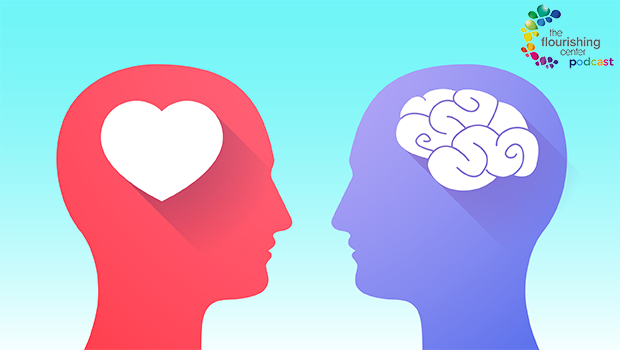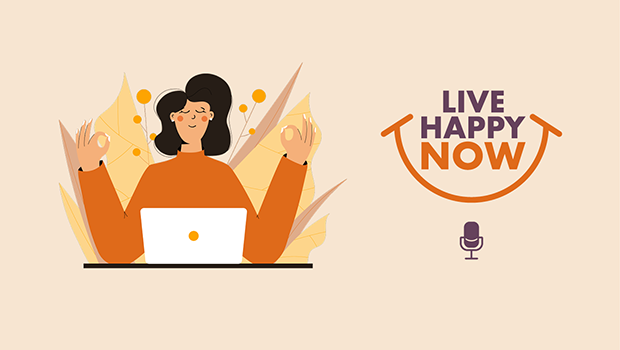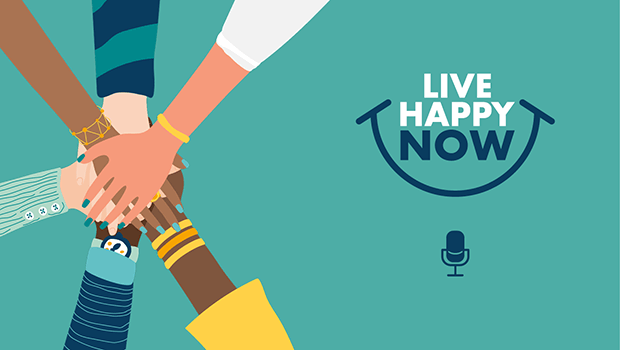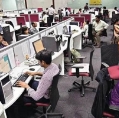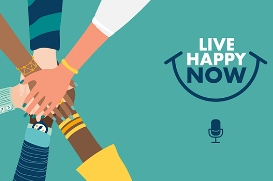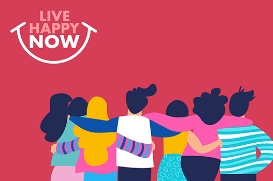What you'll learn in this podcast:
- Science Says—Learn what people who score high in trait emotional intelligence do differently.
- Life Hack—Learn how to further develop your own emotional intelligence.
- Practitioner’s Corner—Find out how one executive coach puts positive psychology into practice with her clients.
Read the interview from the Practitioner's Corner:
Emiliya: Hello everyone, and join me in welcoming Lisa Jacobson. She is a career consultant and leadership coach, and she is incredibly unique in so many ways, and one of which is that she holds both a Masters Degree in Applied Psychology from the University of Pennsylvania, and she's also a graduate of our Certification in Applied Positive Psychology program here at The Flourishing Center. We're so excited to have Lisa with us and learn about how she's been applying positive psychology.
She is an individualizer in our 5i Model, meaning that she uses positive psychology on a one-on-one basis with helping people figuring where are they and where do they want to go in their life.
Lisa: Well, I was a practicing human resources consultant, an internal consultant with Verizon, and I felt as though I reached a plateau in terms of how I could help people in the workplace. I really felt as though I needed more knowledge about what works well in the workplace and so that's what led me to the Masters of Applied Positive Psychology at the University of Pennsylvania.
Emiliya: Beautiful. What brought you to the CAPP program as well?
Lisa: Well, the CAPP program is very interesting to me because I was in the same MAPP program as one of the co-founders, and I felt after several years of practicing positive psychology, I needed a refresher course, and I thought this was one way to find out what's some of the newer research out there and how could I use the existing research in new and different ways.
Emiliya: Tell us, Lisa, how are you using positive psychology personally and professionally?
Lisa: In my coaching practice, it's a very much a full practice. There are probably four different ways in which I practice positive psychology on a full-time basis.
The first one is in Tampa, Florida. I actually have a clientele of young people who are about to graduate college and are undecided about what they want to do with the degree that they'd been earning, and then also some people in the Southeast United States who are currently in the workplace, and they want to maybe make a pivot and change directions in their career for many reasons. It varies considerably. Then I have my executive coaching practice, and what I do in that is there are some firms in the Southeast, businesses, a couple of construction companies that I work with, a research company that I work with, and some health care organizations, and I go into their workplaces, I'm hired usually by the CEO of the company, to work with their leaders who have a lot of potential, and I walk them through a leadership development program.
Finally, what I've added just recently, and I really love it, I didn't know what I was going to think is I actually contract as a 1099 for a coaching organization called BetterUp.
Emiliya: Wow, that is so cool, Lisa. I love the variety of experiences that you get to have in the work that you're doing with people, being in such different places of their life as they're working with you. What are some of the ways in which you find yourself integrating positive psychology as you do this one-on-one work
Lisa: Positive psychology's actually my absolute guiding post for just about any activity that I do with clients. On a basic level, let's say that I'm working with someone about career decisions. The first thing is to guide that person to clarify their goals and to list those goals, and then to agree that they're going to be accountable for those goals, and also that I agree to help the become accountable to those goals and for the goals to be specific and for them to be measurable for them to have an idea of what a good might be.
That would be step number one in just career exploration. There are probably 36 different activities I work with, I use from CAPP or positive psychology that are positive things that tap into a person's strengths to create a greater awareness of what those strengths are, and then to apply those strengths in new and different ways.
I'd like to say that probably one of the most fundamental and most effective methods that I use is the "my best moment" method, and I usually establish that early on in the relationship. I do that because I find that when you ask someone about a best moment in their life, it's a bonding experience with them, so this establishes trust in a fairly quick way, and I share my own best story with them too. I usually have two versions. One that's just kind of an everyday best moment, and then there's a deeper one that I share when I feel we have established maybe greater intimacy, but this best moment story gives people a chance.
It gives my clients an opportunity to reveal who they are, who they have been at their very best. It gives me the opportunity to listen for their strengths and to begin to appreciate what they're good at. When we have this experience of back and forth, like when I tell them, "I heard in this that you're a very creative person, and I saw a lot of curiosity in it as well," then they verify if what I heard is accurate or not. This gets them thinking they've really never thought of before. It just kind of opens the floodgates for ideas.
Emiliya: Wow. Thank you, Lisa. I hear you saying that one of the pillars of your practice is focused on identifying and naming strengths and that you are listening for your client's strengths as you're speaking with them and that you're kind of bringing them out within them as you're sharing, as you're listening to them speak about their goals, their dreams, their aspirations for themselves in life.
Lisa: Yes, exactly, because I really don't know of any formal program or opportunity that people have to begin to find their voice, and by their voice, I mean to be able to answer the question, who am I and why am I here and how do I add value to my family, to my friends, to my organization, to my team. These are such important questions, and it's just, it mystifies me why the first time someone finds themself answering these questions is often with the work that I do with them.
Emiliya: That's such a great point, Lisa, in that we can, as change agents ourselves, start to ask these questions of the people that we know, of the people that we care about that people shouldn't have to wait until they're finding themselves in just a professional setting or place of transition to start to recognize these things about themselves.
Lisa: Sure. I usually start out with a very lighthearted story of when I was, in my early 50s, and I think it's important to note that because I work with a lot of people who are aged 50-plus, and I really try to live out the fact from what we know about change and adult development and positive psychology that we continue to learn and grow, and that improves the quality of my lives.
One of my best moments was when I started to do more exercise, and I actually kind of got that motivation from you because to me, when it comes to positive psychology, you represent the importance of the vitality that people have, and vitality becomes so much more important as you age. We take it for granted when we're younger.
With vitality in mind, I signed up at the local YMCA to take a Body Pump class. That's basically weightlifting to music. It was down the street from where I work, so I would just run over and snag a class. I'd often come to the class late and I would often leave early because I had appointments, and people were paying me to be their coach, and I had a lot of work to do. I was building my practice up, so I didn't take it very seriously, but I thoroughly enjoyed it and loved it.
One day, I came in with flip flops on. In fact, I call this my flip flop story. They were probably into the third routine. The instructor stops the class, and she says, "You can't stay in this class, Lisa, because you're not dressed appropriately. You need close-toed shoes. We're dealing with weights here," and I said, "Well, if you don't mind, I'd just like to stay because I'm here already." She left the room, and I thought everyone in the class, there were 30 people in the class, I thought they would say, "Oh, let Lisa stay," but no one defended me. I was really embarrassed, and I realized at that moment that my late entrance to the class and my early departures were things that people kind of didn't like about me. They didn't come to my defense. Everyone was annoyed because I was holding up the class.
The manager of the YMCA came to the front door, and like a principal, he asked me to come to his office, and then he told me about rules and regulations and safety. I was humiliated for being called out, and I walked home, and something just came inside of me where I just said, "You know, I'm 50 years old, and I can't just act like a little girl here and get angry and hide my head in a pillow. I have to buck up and get back to that class and apologize to the instructor for my lack of motivation and tardiness and just not taking it seriously."
I did, I went back to the class. I finished the class with my shoes on, and then after the class, I walked up to the instructor, and I told her that I apologize, and I said, "I learned a lesson, and the lesson was that I wasn't valuing her time as much as I valued my own, and I wasn't taking the class seriously, and that I would hereafter." She said, "Thank you," and from then on, I took it more seriously, in better shape for it too, but more importantly, I learned that I was disrespecting her, because to me, honestly, and this is still hard for me to admit, I did not value her time as much as I valued my own.
Emiliya: Firstly, I'm so grateful because I can tell you that I, too, am a Body Pump enthusiast, and I, too, have actually been that person who showed up in flip flops and was like, "What do you mean I can't do this class barefoot? I actually really prefer to squat and do things in my barefoot running shoes anyway," and have also been told to leave the class until I am able to come in with sneakers and find myself in that place too. Thank you so much for sharing that at the always in a hurry person within me bows to the always in a hurry person within you and recognizes that we share this in common along with a passion for this particular modality.
As you share that story with your clients, what are some of the strengths that you highlight within ourself or pieces of learning that you hope that they'll capture within that story?
Lisa: Well, first of all, I hope they feel comfortable enough to admit that they're human and even at whatever age, we still have things to learn. It's so important. Even character strengths. They often tell me that they hear the humility in having learned a lesson, and they also hear perseverance, and as much as that I didn't give up, I went back to the class, and they hear honesty and authenticity and bravery.
Bravery is interesting because so many people think bravery has to do with a physical thing, but bravery, as we know from positive psychology, has to do with being brave enough to be honest with yourself and with other people.
Emiliya: You said that that's the more surface-level story. I know that we're just getting to know you, but what's the deeper story that you sometimes share with clients?
Lisa: Well, the deeper story is a story of resilience, and it's one that I have come to really appreciate as I've told certain people. It seems, as a coach, that I really have my whole life together, and it appears as though sometimes people want to be like me. I want to let them know that this was, my journey has been a very long and painful journey with a lot of work involved and a lot of effort.
The story begins just when I was a child. I had a mother and father, but my mother was mentally ill. She had severe psychosis and bipolar disorder. She ended up having four children, and she was really unable to take care of her children. I grew up in Philadelphia, actually, and we used to spend summers at the Jersey Shore. One summer, we were renting a house there, and school was starting, it was late August, and school was starting in September. This is where my mother could really relax, and it would be a vacation for her.
Well, this particular summer, when I was 11 years old, we all got in the car to go back to Philadelphia, and everything was packed up, but my mother would not get in the car to come back to Philadelphia with us. I didn't quite understand it, but she was having yet another nervous breakdown, and she really just said, she came to the car, and she said, "I just can't do this anymore." That was really a tough moment for us all to handle. My father had no choice but to drive us back to Philadelphia. School started, and my mother never came home. That was September.
Then in October, it was my birthday, and still, mom did not come home. November was Thanksgiving, no mom. December was Christmas, again, mom, it seemed as though she was just not going to return. It seemed as though she decided she could not raise her four children.
In January, my father called his family in Tampa, Florida and asked if they could help raise us. We moved into a little two bedroom house with my great-aunt who I've never met before, and we started our lives all over again. Needless to say that that was a very though, bewildering time for me, and I just did what I had to do. I put one foot in front of the other to get through it.
The toughest part, really, was as a teenager growing up in a new environment, people would always ask, "Well, where's your mom?" I would say, "She's very, very sick, and I don't think she's ever coming here. That, it's like she's terminally sick," I would say. I kind of make up stories as a kid. Then they found out, basically, that my mother was chronically mentally ill, and she gave us up to my dad. Kids make fun of stuff like that, and they think you're weird, and they don't want to be around you, and they think there's just something wrong with you and your family. A lot of judgment of the stigma of mental illness.
I grew up with adversity that way, not having a mother, then it being kind of an illness that has a stigma, and then facing the fact that was abandoned by my other, and then being raised by man and dealing with all that going to high school and college and so forth. I just had to make my own way and make the best of the circumstances that I had. It wasn't easy, but I found my way forward, and I did it. That's my story.
Emiliya: It's an amazing thing to put the two strength stories together because you can hear the honesty and the authenticity and the bravery that comes with both being honest with yourself and also the bravery to just do what needs to be done and putting one foot in front of the other in stories of resilience like this one. Thank you so much for sharing that, Lisa.
Lisa: You're welcome. Bottom line there is that I was very, very sad, sad, sad, sad, as a child, and I found that you can do things to make your life matter. You don't have to resign to what your life circumstances have given you. That's what I've learned. Actually, my adulthood has been a lot happier than my childhood.
Emiliya: What are some ways that you personally practice positive psychology in adulthood that give you that sense of happiness and well-being and life satisfaction?
Lisa: Well, I practice mental hygiene. I think that's a term, actually, I got from you in the CAPP course. I start every day of my life quietly in meditation. Before I do anything, I practice meditation. I set intentions for the day, and it's usually 15 to 20 minutes of my practice in setting intentions. Then I routinely practice yoga twice or three times a week, and I exercise twice or three times a week as well.
These things are absolutely staples in my life. I not only coach actively with the science of positive psychology being my primary toolbox, but I live it. I practice gratitude as well every day, and so does my husband. We've been doing that for 10 years now, sometimes more consistently than others, but before I open my computer and I check my email, I write down three things for which I am grateful or three things that went well.
Well, it sets the tone for the day for me, but with the gratitude, meditation, exercise, yoga, it all comes together. There's this synergy there too. There's definitely a synergy, and let me tell you, Emiliya, as you know, in studying for my masters, I couldn't sit still to meditate for three minutes. It has taken me years to work up to the 20 minutes that I now do. I tell people that because they think, "Oh, I just can't meditate," and I say, "This is something for some people that takes years of practice."
Emiliya: I'm definitely in the same boat as well. I can't tell you how many times I … I mean, I've been at it for over 14 conscious years of when I first learned about meditation to getting to the point where I do do it, I do it frequently, still not every day, and so one of the things that's helped me is reminding myself that what we do on the cushion is what we do off the cushion, and that on the cushion, your mind wanders, and you come back, and your mind wanders, and you come back, and what's most important is not that you have a clear mind, but that you keep coming back. That's definitely helped me having some more compassion towards myself on days when I haven't been meditating. It's all about coming back.
Lisa: That's probably the benefit for staying at it for 10 years is that I am able, through the course of the day, to center myself. In a matter of a second, I can go to that place. It's my reset button, and it's wonderful.
Emiliya: Beautiful. What have been some of the more powerful interventions and exercises that you've used with your clients as you've been sharing positive psychology with them?
Lisa: At BetterUp, I've found that people in the workplace are starving for things that they can use in the workplace to avoid running down the hall and getting a Snickers bar or something because they're stressed out. A lot of us at work, we're stressed because we're stretched to reach our goals, and we can easily break down by, we even break down that self-discipline muscle we have. It's important to set ourselves up for success, and one of the ways that we can do that is by being prepared, by planning in advance for when things go wrong.
One of the things I love to do is encourage people to figure out what works specifically for them when they're stressed out to de-stress and to calm down and to not do something negative like go, for me, it used to be go the, we used to have snack machines, and go to snack machine and get a Snickers bar. There a number of things that you can do, and one of them is what I call a BMW, and that just means try breathing first. We talk a lot about how breathing actually helps, a conscious breathing, helps at least bring more oxygen to the brain. One of the first things that even physicians do is when they're trying to figure out what's wrong with someone is figure out how much oxygen do they have in their blood, and so it's very important thing to understand that your bloodstream is getting oxygen. The simplest most fundamental way of doing that is to be conscious of your breathing and to do it more efficiently and effectively.
The M stands for move, so if the breathing still makes you go have an urge for a Snickers bar I say move. Walk around the building, walk around the parking lot, the parking garage, but see if that can distract you. Then W is water, of course. Hydrate. Drink a glass of water and see if that doesn't … If you tried all three of those things and you still have this urge to feed that stress with some kind of unhealthy habit, I guess you tried not to.
That's one little intervention that I use in the workplace because most of the time, no matter where anybody works, it's stress is the biggest issue with them, effectively dealing with stress, using stress in a positive way, so here's an example of using stress in a positive way. This is another thing that I took away from [inaudible 00:31:06] with Louis at CAPP, and that is, instead of, I have to do something, I get to do something.
Emiliya: Beautiful, Lisa. Thank you so much for sharing some of these powerful interventions with us that you integrate into your work. I'm curious if we could close our time off together with anything that you are really excited about within the field of positive psychology that you're reading or researching right now that's top of mind for you?
Lisa: I think decision making is one of, it's a very common topic for positive psychology. People want to make better decisions, and what we keep finding is that decisions are better made when you discuss them objectively, bringing that objective quality into them, and that's why working with a coach, it doesn't have to be a coach, but working with a coach or a mentor, someone, just talking about the steps of your decision making with someone has a positive impact on the change that you want to make in your life.
Emiliya: Awesome. Well, thank you so much, Lisa. Thank you for taking the time to share your expertise in your practice of positive psychology with us.
Lisa: Thank you. It was my pleasure.
Emiliya: Lisa, if people wanted to find out m ore about your work, where could they find you?
Lisa: They can Google Lisa Garcia Jacobson.
Emiliya: Beautiful. Thank you, Lisa.
Lisa: Thank you. Bye.
Emiliya: Learn more about Lisa Jacobson's work at workplacesolutionstampa.com, including her interview bootcamp, career services, and executive coaching.
Speaking of interviews, check out our website theflourishingcenter.com/5imodel. That's the number 5, the letter i, and the word model. This is a questionnaire that we've established to help you figure out which of the five change agent types you fall into, and based on identifying what type of change agent you are in the world, let us help you identify your personalized road map for success in helping you spread positive psychology in the science of flourishing around the world.


